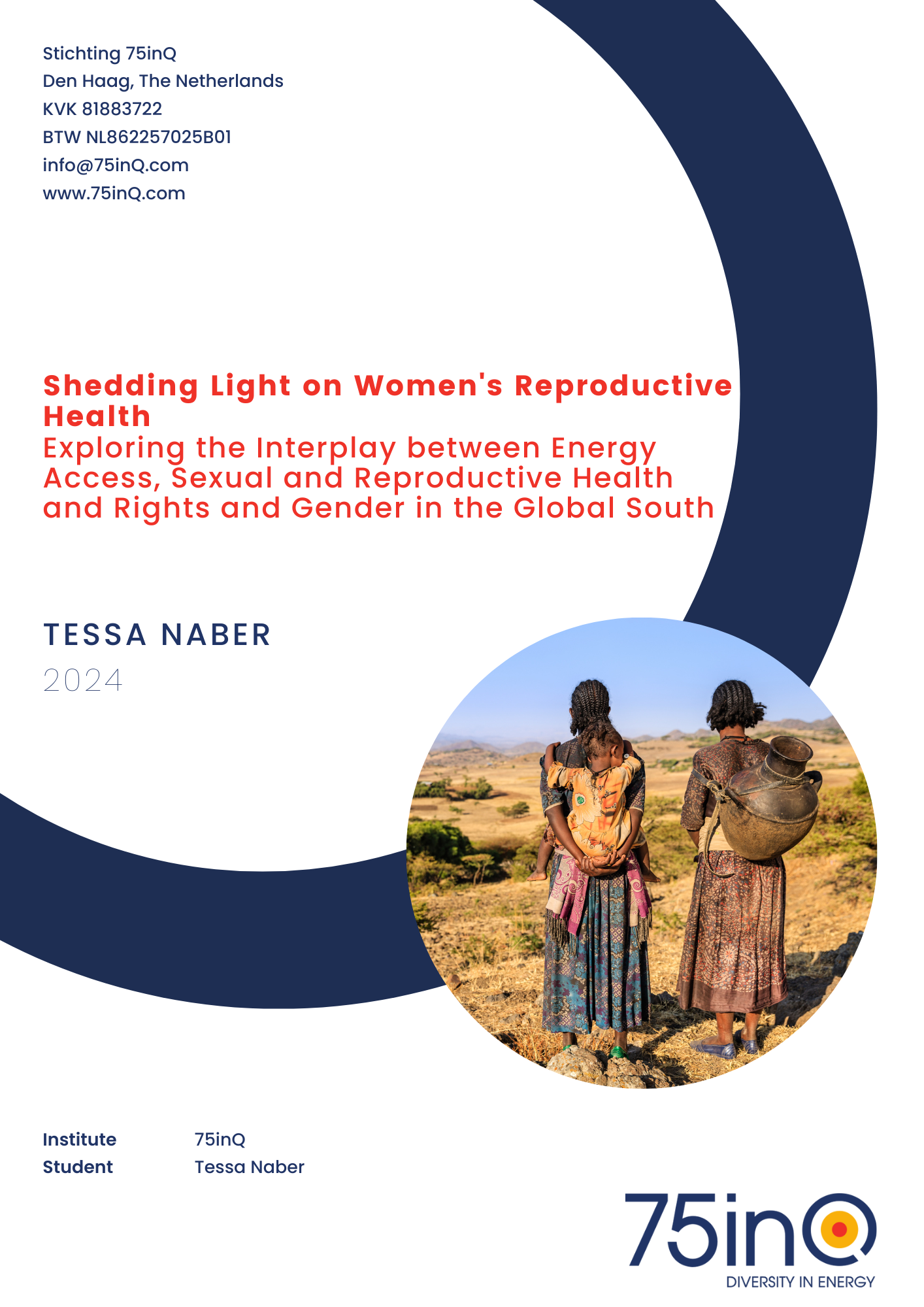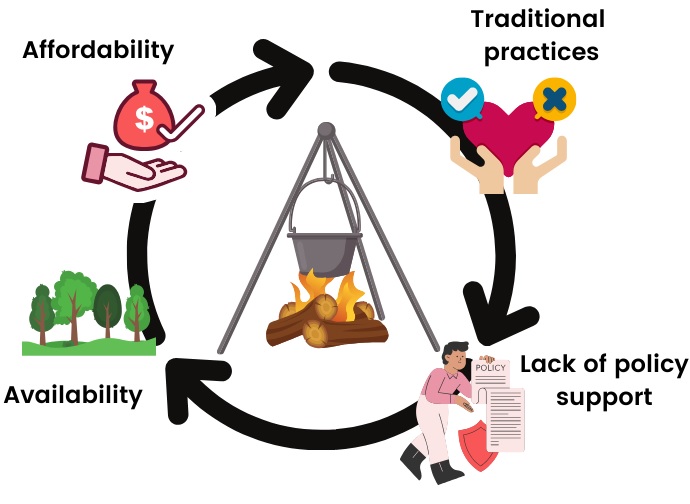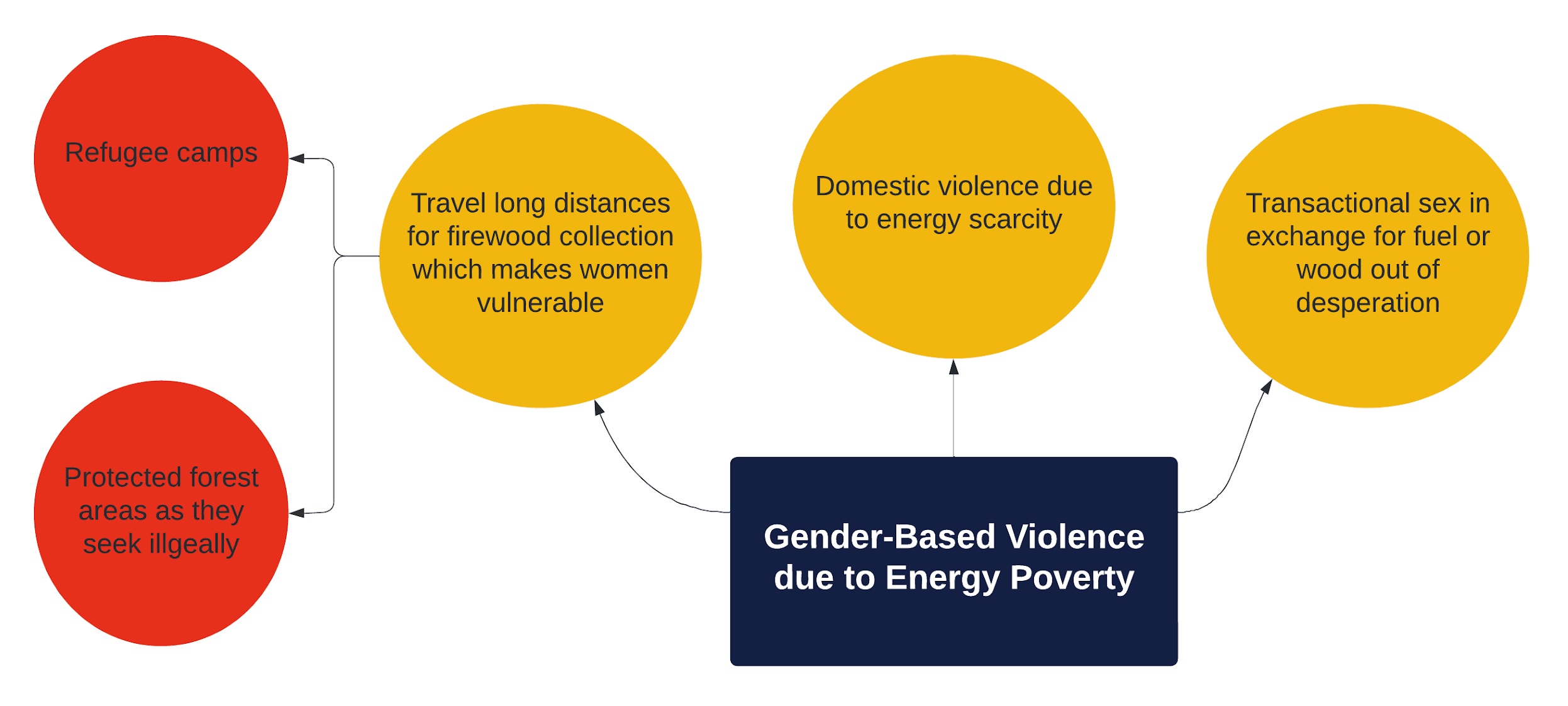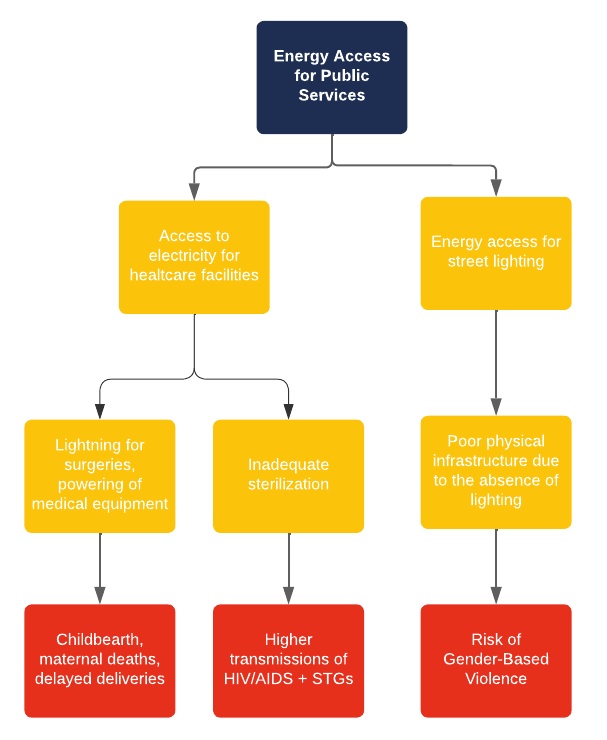Shedding light on women’s reproductive health
exploring the interplay between energy access, sexual and reproductive health and rights and gender in the global south
November 2024
Citation
Naber, T. (2024) Shedding light on women’s reproductive health. 75inQ

Shedding light on women’s reproductive health
Summary & recommendations
| Date | November 2024 |
| Authors | Tessa Naber |
Context
The Sustainable Development Goals (SDGs) set by the United Nations aim to eradicate poverty, promote well-being, and protect ecosystems by 2030. To accelerate progress on the achievement of these goals, decision-makers are encouraged to focus on interventions that leverage synergies across multiple SDGs. The interconnections between SDGs 3 (Health and Well-being), SDG 5 (Gender Equality) and SDG 7 (Clean Energy), highlight the need to address these issues collectively. Access to modern energy is essential for health and well-being, particularly for women’s sexual and reproductive health and rights (SRHR). Despite this, energy poverty remains a critical issue, especially in the Global South, where many still rely on polluting biomass for cooking, leading to health risks, disproportionately affecting women.
Addressing the gendered dimensions of energy access is crucial to improving women’s SRHR. However, there are still significant research and policy gaps in understanding how energy, gender equality, and SRHR intersect. This paper explores how these factors influence women’s SRHR, focusing on developing targeted interventions through a qualitative analysis of existing literature, with a primary focus on the Global South.
Energy Access and Gender
Reliable and affordable energy is a fundamental aspect for economic growth and improving living standards. Challenges of energy access are commonly described as energy poverty. In this paper, two elements of energy access are applied to address the intersection of energy access and SRHR: household energy access and energy access for public services.

Access to energy is not gender-neutral, it intersects with existing gender inequalities, resulting in differential experiences of energy poverty and its associated health risks for women worldwide. Women, as primary energy consumers and managers of household energy, may face unique challenges due to energy poverty. Factors like economic conditions, physiological vulnerabilities, and socio-cultural responsibilities exacerbate the impacts of energy poverty, affecting them disproportionately. A just energy transition requires recognizing these gendered differences.

Gender and SRHR
Sexual and reproductive health and rights (SRHR) are closely linked to gender equality. Achieving SRHR requires individuals to make decisions about their sexual and reproductive lives free from violence, coercion, and discrimination, which is only possible with gender equality (IPPF, 2023). However, many women, especially in patriarchal societies, lack control over key decisions related to sexual health due to discriminatory norms, lack of education, and social stigma, leading to adverse health outcomes. Improved access to SRHR services enhances women’s health, economic participation, and empowerment. To address existing SRHR inequalities, a gender-transformative approach is required, which aims to challenge harmful norms and power imbalances. Overall, a comprehensive approach that addresses gender norms and empowers women is essential for achieving SRHR and true gender equality.
The Intersection of Energy Access, Gender and SRHR
The previous sections of gender intersecting with energy access and SRHR are needed to understand the complex interplay of challenges related to all three dimensions. Women suffering from energy poverty have to navigate through systemic barriers, socio-cultural norms and structural inequalities, intersecting with their SRHR (UNDESA, 2018). This paper addresses multiple dimensions of energy poverty which influence women’s SRHR, within household energy access and energy access for public services.

Household Energy Access
The relationship between household energy access and women’s SRHR is multifaceted, involving health risks, physical burdens and exposure to violence:
- Lack of Modern Energy for Cooking Methods: Women in energy-poor households predominantly rely on biomass fuels (wood, charcoal, crop residues), leading to significant indoor air pollution (IAP) and household air pollution (HAP). Exposure to toxic pollutants from these fuels is linked to severe health issues. Studies indicate that maternal exposure to IAP correlates with increased risks of perinatal mortality and morbidity, such as stillbirths and low birth weights.
- Physical Strain and Maternal Health: Women often bear the responsibility of collecting biomass fuels, a task that involves carrying heavy loads over long distances. This physical strain can have severe consequences, particularly for pregnant women, leading to complications such as obstructed labor, lower uterine pain, and increased maternal and neonatal mortality (Knight-Agarwal et al., 2023; G. M. Shaw, 2003).
- Domestic Responsibilities and Access to Information and Resources: The time-consuming nature of household energy tasks, such as fuel and water collection or cooking, limits women’s autonomy, leaving little opportunity for them to seek reproductive healthcare or education. This “time poverty” also affects their ability to make informed decisions about family planning and maternal care. Lack of modern energy restricts connectivity, further depriving women of essential information on SRHR (Ngilangwa et al., 2016). Improved energy access can facilitate better health outcomes, as seen in electrified households with exposure to media like TV (D. Shaw, 2009).
- Gender-Based Violence when Collecting Firewood: Collecting firewood exposes women and girls to significant risks of physical and sexual violence, especially in vulnerable settings such as refugee camps. Women are often targeted by perpetrators when they travel long distances to gather fuel, leading to cases of harassment, assault, and even transactional sex in exchange for cooking fuel (CRGGE, 2006; UN Women, 2014). Such violence not only harms women physically, increasing risks of sexually transmitted infections or unwanted pregnancies, but also restricts their reproductive health choices and access to essential services (ARROW, 2011).

Energy Access for Public Services
Reliable and sustainable energy infrastructure is essential for creating safe and accessible environments. Energy access for public services highlights the importance of creating reliable energy for supporting women’s SRHR:
- Healthcare Facilities Energy Access: Access to electricity in healthcare facilities is crucial for providing comprehensive SRHR services. The absence of electricity hampers maternal and neonatal health services, impacting prenatal care, childbirth, family planning, and emergency response in rural areas (CRGGE, 2006). Electrification supports surgeries, medical equipment operation, and sterilization, critical for reducing maternal and neonatal mortality (UN Women, 2014).
- Gender-Based Violence due to Street Lighting and Safety: Improving public lighting systems is necessary for enhancing safety, especially for women in urban and rural areas. Inadequate lighting exacerbates the risk of physical and sexual violence, affecting women and children disproportionately (UN Women, 2017). Gender-sensitive lighting initiatives highlight the need for inclusive urban planning that considers gender-specific safety concerns and involves women in project development and evaluation (Belitardo, 2023; Matte et al., 2021).

Conclusion
This paper examines the complex interplay between energy access, gender and SRHR. It identifies significant implications for women suffering from energy poverty, particularly in the Global South, which includes:
- the increased risk of gender-based violence women face in collecting firewood,
- the increased vulnerability of women to physical and psychological health risks due to the weight of carrying firewood
- the health risks on maternal and neonatal health due to the use of biomass fuels,
- the restricting opportunities for SRHR education,
- the vulnerability to gender-based violence due to poor lighting in public spaces
- and the critical impact of energy access on healthcare facilities delivering maternal and neonatal services.
Future Research
To address these challenges, gender-transformative policy frameworks should be implemented prioritizing women’s SRHR within energy access initiatives and vice versa. It emphasizes the importance of community involvement and women’s leadership in shaping solutions. Further research is necessary to deepen understanding, exploring:
- Development of targeted interventions and policy programs
- Differences between the Global North and the Global South
- Implications of energy poverty on women’s workforce participation
- Sex-disaggregated data on the nature and scale of the problem
References
- ARROW. (2011). Gender-Based Violence and Sexual and Reproductive Health and Rights: Looking at the Health Sector Response in the Asia-Pacific Region. Asian-Pacific Resource & Research Centre for Women (ARROW), 17(2). https://arrow.org.my/wp-content/uploads/2015/04/AFC-Vol.17-No.2-2011_Gender-based-Violence-and-Health-Sector.pdf
- Belitardo, A. (2023, March 31). The Importance of Gender-Sensitive Public Lighting. ArchDaily. https://www.archdaily.com/998329/the-importance-of-gender-sensitive-public-lighting> ISSN 0719-8884
- CRGGE, A. (2006). From the Millennium Development Goals Towards a Gender-Sensitive Energy Policy Research and Practice: Empirical Evidence and Case Studies.
- Knight-Agarwal, C., Minehan, M., Cockburn, B., Cashel, S., & Takito, M. Y. (2023). Different experiences of weight management and physical activity during pregnancy—A qualitative study of women and healthcare professionals in Australia. International Journal of Qualitative Studies on Health and Well-Being, 18(1), 2202973. https://doi.org/10.1080/17482631.2023.2202973
- Matte, J., Meyer, A., & Ton, M. (2021). Gender-sensitive public lighting: Why and how? Agence Francaise de Development (AFD). https://comssa.org/en/site-resources/user-guide-gender-sensitive-public-lighting-how-and-why?utm_medium=website&utm_source=archdaily.com
- Ngilangwa, D. P., Rajesh, S., Kawala, M., Mbeba, R., Sambili, B., Mkuwa, S., Noronha, R., Meremo, A. J., & Nyagero, J. (2016). Accessibility to sexual and reproductive health and rights education among marginalized youth in selected districts of Tanzania. The Pan African Medical Journal, 25(Suppl 2), 2. https://doi.org/10.11604/pamj.supp.2016.25.2.10922
- Shaw, D. (2009). Access to sexual and reproductive health for young people: Bridging the disconnect between rights and reality. International Journal of Gynecology & Obstetrics, 106(2), 132–136. https://doi.org/10.1016/j.ijgo.2009.03.025
- Shaw, G. M. (2003). Strenuous work, nutrition and adverse pregnancy outcomes: A brief review. The Journal of Nutrition, 133(5 Suppl 2), 1718S-1721S. https://doi.org/10.1093/jn/133.5.1718S
- UN Women. (2014). World Survey on the Role of Women in Development 2014: Gender Equality and Sustainable Development. United Nations.
- UN Women. (2017). Safe Cities and Safe Public Spaces: Global results report. https://www.unwomen.org/en/digital-library/publications/2017/10/safe-cities-and-safe-public-spaces-global-results-reportUNDESA. (2018). Accelerating SDG7 Achievement: Policy Briefs in Support of the First SDG 7 Review at the UN High-Level Political Forum 2018. United Nations Department of Economic and Social Affairs. https://sustainabledevelopment.un.org/content/documents/17489PB12.pdf

